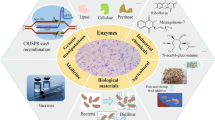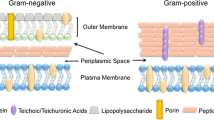Abstract
Bacteria are social organisms capable of collective behaviors mediated by chemical communication or “quorum sensing” (QS). However, QS signal molecules often have multiple biological functions. Because many bacteri al pathogens regulate virulence gene expression via QS, these systems are attractive targets for antivirulence therapies. One possible strategy to interfere with QS is signal inactivation by quorum quenching enzymes.
Similar content being viewed by others
Literatur
Hense BA, Kuttler C, Müller J et al. (2007) Does efficiency sensing unify diffusion and quorum sensing? Nat Rev Microbiol 5:230–239
Fuqua WC, Winans SC, Greenberg EP (1994) Quorum sensing in bacteria: the LuxR-LuxI family of cell densityresponsive transcriptional regulators. J Bacteriol 176:269–275
Brameyer S, Bode HB, Heermann R (2015) Languages and dialects: bacterial communication beyond homoserine lactones. Trends Microbiol 23:521–523
Drees SL, Fetzner S (2015) PqsE of Pseudomonas aeruginosa acts as pathway-specific thioesterase in the biosynthesis of alkylquinolone signaling molecules. Chem Biol 22:611–618
Fetzner S (2015) Quorum quenching enzymes. J Biotechnol 201:2–14
Soh EY, Chhabra SR, Halliday N et al. (2015) Biotic inactivation of the Pseudomonas aeruginosa quinolone signal molecule. Environ Microbiol 17:4352–4365
Müller C, Birmes FS, Rückert C et al. (2015) Rhodococcus erythropolis BG43 genes mediating Pseudomonas aeruginosa quinolone signal degradation and virulence factor attenuation. Appl Environ Microbiol 81:7720–7729
Williams P, Cámara M (2009) Quorum sensing and environmental adaptation in Pseudomonas aeruginosa: a tale of regulatory networks and multifunctional signal molecules. Curr Opin Microbiol 12:182–191
Reen FJ, Mooij MJ, Holcombe LJ et al. (2011) The Pseudomonas quinolone signal (PQS), and its precursor HHQ, modulate interspecies and interkingdom behaviour. FEMS Microbiol Ecol 77:413–428
Hazan R, Que YA, Maura D et al. (2016) Auto poisoning of the respiratory chain by a quorum-sensing-regulated molecule favors biofilm formation and antibiotic tolerance. Curr Biol 26:1–12
Filkins LM, Graber JA, Olson DG et al. (2015) Coculture of Staphylococcus aureus with Pseudomonas aeruginosa drives S. aureus towards fermentative metabolism and reduced viability in a cystic fibrosis model. J Bacteriol 197:2252–2264
Author information
Authors and Affiliations
Corresponding author
Additional information
Franziska S. Birmes 2009–2012 Studium der Biowissenschaften (Bachelor) und 2012–2014 Studium der Biotechnologie (Master) an der Universität Münster. Seit 2015 Promotion am Institut für Molekulare Mikrobiologie und Biotechnologie der Universität Münster.
Susanne Fetzner 1982–1990 Studium der Biologie (Diplom) und Promotion an der Universität Hohenheim. 1996 Habilitation in Mikrobiologie, anschließend Vertretung der Professur für Mikrobiologie an der Universität Oldenburg. Seit 2002 C3-Professorin für Mikrobiologie an der Universität Münster; Leiterin der Arbeitsgruppe „Biochemie bakterieller Stoffwechselprozesse“.
Rights and permissions
About this article
Cite this article
Birmes, F.S., Fetzner, S. Bakterielle Kommunikation: Signale und Signal-inaktivierende Enzyme. Biospektrum 22, 251–254 (2016). https://doi.org/10.1007/s12268-016-0681-4
Published:
Issue Date:
DOI: https://doi.org/10.1007/s12268-016-0681-4




